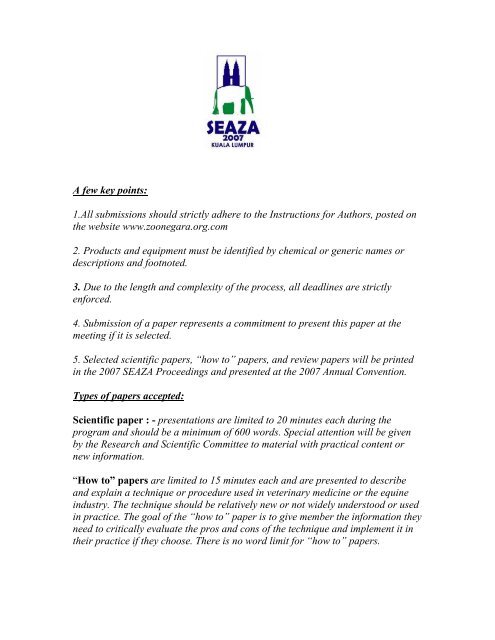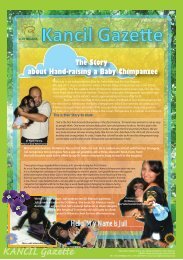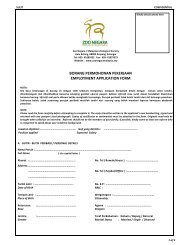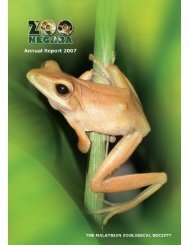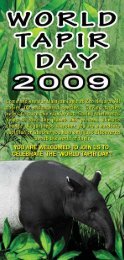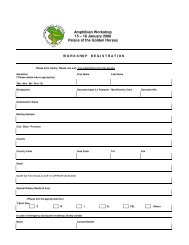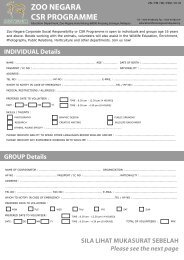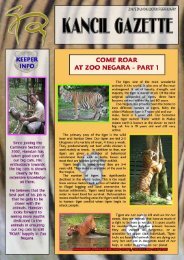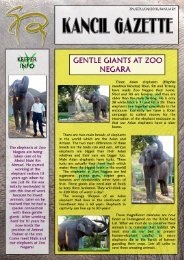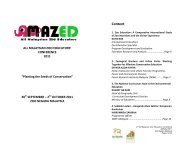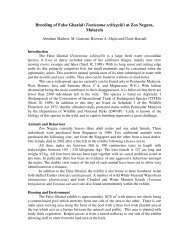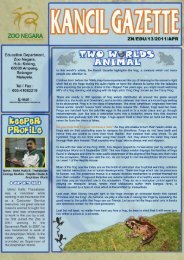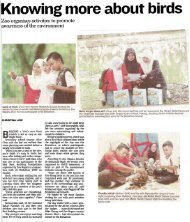Guidelines For Authors - Zoo Negara
Guidelines For Authors - Zoo Negara
Guidelines For Authors - Zoo Negara
Create successful ePaper yourself
Turn your PDF publications into a flip-book with our unique Google optimized e-Paper software.
A few key points:1.All submissions should strictly adhere to the Instructions for <strong>Authors</strong>, posted onthe website www.zoonegara.org.com2. Products and equipment must be identified by chemical or generic names ordescriptions and footnoted.3. Due to the length and complexity of the process, all deadlines are strictlyenforced.4. Submission of a paper represents a commitment to present this paper at themeeting if it is selected.5. Selected scientific papers, “how to” papers, and review papers will be printedin the 2007 SEAZA Proceedings and presented at the 2007 Annual Convention.Types of papers accepted:Scientific paper : - presentations are limited to 20 minutes each during theprogram and should be a minimum of 600 words. Special attention will be givenby the Research and Scientific Committee to material with practical content ornew information.“How to” papers are limited to 15 minutes each and are presented to describeand explain a technique or procedure used in veterinary medicine or the equineindustry. The technique should be relatively new or not widely understood or usedin practice. The goal of the “how to” paper is to give member the information theyneed to critically evaluate the pros and cons of the technique and implement it intheir practice if they choose. There is no word limit for “how to” papers.
Review papers: -are limited to 20 minutes each and are presented for the purposeof updating the membership on a new subject or for gathering information thatmay be conflicting. The aim of the paper is to help the membership put theinformation in perspective, and to make judgments on conflicting information.Although a review paper does not necessarily contain original data, it isanticipated that the presenter will be someone with considerable experience in thefield.Abstracts < 250 words are limited to 20 minutes. <strong>Authors</strong> who intend to publishin a refereed journal may submit an abstract < 250 words. An should allow thereviewers to assess the experimental design, materials and methods, statisticalanalyses, results and a discussion of the results as it pertains to interpretation andconclusions. Any questions should be directed to Dr Mohd Azam Khan, SEAZAscientific publications coordinator by e-mailing azamkhan@cybermed.edu.myINSTRUCTION TO AUTHORS<strong>For</strong>mat:Current return address, phone, fax, and e-mail address of the primary author must beincluded.• Word limit according to type of paper.• Font size must be 12 points.Only the Times, Times New Roman, arial are approved for useHeadings should include (but are not limited to) the following:1. Summary2. Introduction3. Materials and Methods4. Results5. Discussion6. ReferencesTitle: The title of the paper should be 15 words or fewer, at the top and on the first pageof the Scientific Paper.
Example:“The <strong>For</strong>aging Behavior Enrichment of Primates in Taipei <strong>Zoo</strong>”<strong>Authors</strong>:The list of authors should include each author’s full name with middle initial. The nameof the presenting author must be underlined.Example:1. Mohd A. Khan; Abdul R Alimon; Mohammad Ngah and 2 Somebody N. Me<strong>Authors</strong>’ Addresses: <strong>Zoo</strong> <strong>Negara</strong> 1 , Jalan Ulu Kelang, Kuala Lumpur and 2 Faculty ofVeterinary Medicine, Universiti Putra Malaysia, Serdang, Selangor.Summary:This should be a short, concise summarization of the main conclusion and should be nolonger than two or three sentences (approximately 50 words). “How to” and in-depthpapers do not require a summary.Introduction:The rationale for the Scientific Paper or study should be given briefly and significantpublished work acknowledged here. The clinical significance should also be included, aswell as a clear statement of the objective or purpose of the Scientific Paper or study. Thestatement of objectives is usually found in the last sentence of the Introduction.Materials and Methods:This section should describe experimental methodology in the case of a didactic study or,in the case of a clinical study, should include a description of the population from whichthe animals were selected and how they were selected for inclusion in the report.Data obtained and how they were obtained must be described. A description of thestatistical methods used to summarize data, test hypotheses, and characterize thesignificance of results should also be included. <strong>For</strong> weights and measures, metric unitsshould be used. Dosages should be expressed entirely in metric units and with specifictime intervals.Results:Actual results with numbers and data must be presented. When possible, quantifyfindings (mean, median, proportion) and present them with appropriate estimates ofmeasurement error or uncertainty (such as standard deviation (SD), standard error (SE) orconfidence interval) in addition to the results of hypothesis testing. If the data can be wellrepresented with a graph or figure, these are encouraged if subsequent publication is notanticipated. If numbers and data are not presented due to concerns regarding publication
in a refereed journal, indications of relative differences between groups such as oddsratios, % change, and significant differences must be included in the Scientific Paper tobe considered acceptable. In these instances, the authors should submit the data in theform of means, standard deviations, or other descriptions of comparisons among groupsin an appendix, which will not be published and only used for review purposes.Discussion:Important findings documented in the results of the study should be stated. Results shouldbe related to other work which has been done and how the results differ or agree withpreviously published work and why any differences may have occurred should bediscussed. The practical take home message for the equine practitioner should be clearlydefined and stated in thesummarizing final statement. This statement may be longer, but should be similar incontent to the take home message at the beginning of the paper.References:All manuscripts must include references, including Scientific Papers, “How to”, Review,and In-depth papers. References to published works should be limited to what is relevantand necessary..Examples:Journal article:Murphy, CJ., Lavoie JP and Groff, J. (1989). Bilateral eyelid swelling attributable tolymphosarcoma in a horse. J Am Vet Med Assoc; 194:939-942.Book:Woods, LW. (2001). Adenoviral disease. In Infectious disease of wild animals. 3 rdedition. ES. Williams and IK. Barker (eds) Iowa State University Press, Ames, Iowa, pp202 – 212.Proceedings:Lamb, CR., Koblik, PD. and O’Callaghan, MW. (1989). Comparison of bonescintigraphy and radiography as aids in the evaluation of equine lameness: Retrospectiveanalysis of 275 cases, in Proceedings. Am Assoc Equine Pract; 35:359-368.Acknowledgments:Acknowledgments should include financial and material support for research.Audiovisual Needs:
Audiovisual equipment can be expensive to rent. Please request only what is essential foryour proposal. The moderator must determine the AV needs for each speaker and submitthe complete AV request in the proposal


